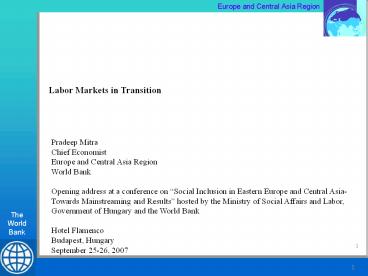Poverty and Inequality in Transition - PowerPoint PPT Presentation
1 / 11
Title:
Poverty and Inequality in Transition
Description:
RLT Workshop, Kiev. 1. Europe and Central Asia Region. The World Bank. 1. Pradeep Mitra ... RLT Workshop, Kiev. 2. Europe and Central Asia Region. The World Bank. 2 ... – PowerPoint PPT presentation
Number of Views:19
Avg rating:3.0/5.0
Title: Poverty and Inequality in Transition
1
Labor Markets in Transition
Pradeep Mitra Chief Economist Europe and Central
Asia Region World Bank Opening address at a
conference on Social Inclusion in Eastern Europe
and Central Asia-Towards Mainstreaming and
Results hosted by the Ministry of Social Affairs
and Labor, Government of Hungary and the World
Bank Hotel Flamenco Budapest, Hungary September
25-26, 2007
2
Income per capita is less than half of the EU-15
average for even the wealthiest subgroup of ECA
countries and a quarter of the EU-15 average for
the other ECA middle income countries
3
Growth in GDP per capita from 1998 to 2006, the
most rapid for CIS countries recovering from a
deep transitional recession, owes more to growth
in labor productivity (GDP/EMPL) than improved
employment rates (EMPL/Working POP) or favorable
demography (Working POP/POP)(Growth in GDP/POP)
(Growth in GDP/EMPL) (Growth in EMPL/Working
POP) (Growth in Working POP/POP)
4
Indeed the employment rate (EMPL/Working POP)
continued to fall inmany countries even after
1998. Slack labor markets are manifest in either
open unemployment, falling labor force
participation or low-productivity employment.
While the employment rate is generally higher in
CIS countries compared to Eastern Europe, many
jobs in the CIS are in low-productivity
occupations.
Employment Rates Early Transition, 1998 and 2006
Note The earliest years (blue bars) for each
country are as follows 1990Azerbaijan, Belarus,
Bulgaria and Estonia 1992 Hungary, Russia 1993
Armenia, Czech Republic, Kazakhstan, Poland and
Slovenia 1994 Albania, Lithuania, Romania and
Slovak Republic. 1995 Moldova and Ukraine.
Source ILO LABORSTA database, World Development
Indicators Note The employment rate in Moldova
between 1998 and 2003 shows a decline based on
LFS but an increase based on household survey
data on account of a likely more restrictive
definition of informal sector employment in the
LFS.
5
Labor Force Participation Rates are lower in
Eastern Europe compared even to the EU15 and are
particularly low for older age groups and women
6
While the population is expected to decline by
over 15 percent by 2025 in Ukraine, Bulgaria and
Georgia on account of aging, it is expected to
expand by over 30 percent by 2025 in Turkey,
Turkmenistan, Uzbekistan and Tajikistan
Percentage Change in Population in ECA Countries,
2000-2025
Source UN Population Prospects
7
The share of working age population to total
population is expected to decline rapidly after
2015 in all subgroups of countries except Turkey
and (Azerbaijan and low income Central Asia),
with potentially adverse consequences for growth.
8
Increasingly dynamic labor markets in transition
economies were reflected in rise in the sum of
job creation and job destruction rates to levels
broadly comparable to those in developed
countries and lagging slightly below those in
developing countries
Source Bartelsmann and Scarpetta (2007) Brown
and Earle (2007)
9
New firms played a major role in job creation in
the early years of the transition 70 to 90 in
Hungary and Romania 60 to 80 in Ukraine and
50 to 70 in Russia. This share fell later to
20 except that in Russia and Ukraine it
increased when firm entry rose following the 1998
Russia crisis. This underlines the importance of
the demand side of labor markets in transition.
Source Brown and Earle (2007)
10
Conclusions
- Rapid economic growth during 1998-2006 has been
driven more by increases in aggregate labor
productivity than job creation. - The employment rate has continued to fall in many
countries even after 1998. While the employment
rate is generally higher in CIS countries, many
jobs in the CIS are in low-productivity
occupations. Participation of older and female
workers is particularly low in Eastern Europe. - Aging and the associated decline in the share of
working age population in total population
expected after 2015 in Eastern Europe and middle
income CIS countries, taken together with limited
utilization of labor reflected in low
participation, has the potential to derail
convergence to EU15 living standards.
11
Conclusions (cont.)
- Entry of new firms has been important for job
creation, particularly in the early years of
transition and also in Russia and Ukraine during
the recovery from the 1998 crisis. Whereas new
firms have expanded employment, existing firms
have, on average, improved productivity by
shedding labor. Hence the business environment
facing firms is an important demand side
determinant of labor market outcomes. - Activation policies (that encourage job seekers
to become more active in their efforts to find
work by providing job search support and
requiring regular contact with employment
services as well as compulsory participation in
programs after a certain period of unemployment)
can increase labor utilization, but only in
conjunction with improvements in the business
environment to address the demand side of the
labor market, as well as policies to alleviate
shortages of labor skills that are increasingly
emerging in the new EU members.































